Suffrage Connection
If you did not go to the pre-screening of the movie The Suffragette at the Smith, you missed an incredible experience. Though the movie was about the British suffrage movement, there is a Geneva connection.
Established in 1897, the Geneva Political Equality Club was a forum to discuss local and public questions and educate people about women’s rights. Men and women could be members of the club. Along with monthly meetings, the club hosted lectures, social events, classes in civics, and an annual essay contest for high school students. Under the leadership of the mother-daughter team of Elizabeth and Anne Miller the club became the largest of its kind in New York State.
The Millers also used their connections to bring Pankhurst and other national known suffragettes to speak in Geneva.
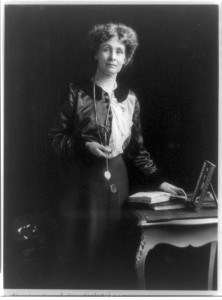 In 1909 Emmeline Pankhurst (portrayed in the movie by Meryl Streep) spoke at the Smith Opera House. Tired of Parliament’s inaction on women’s suffrage, Pankhurst organized the Women’s Social and Political Union (WSPU) in 1903. With the slogan “deeds not words,” the WSPU first used nonviolent strategies (speeches, petitions, and rallies) but increasingly members turned to physical tactics (smashing windows, vandalizing public art and arson) to agitate for women’s suffrage. Several members, including Pankhurst and her daughters, were jailed for their activities
In 1909 Emmeline Pankhurst (portrayed in the movie by Meryl Streep) spoke at the Smith Opera House. Tired of Parliament’s inaction on women’s suffrage, Pankhurst organized the Women’s Social and Political Union (WSPU) in 1903. With the slogan “deeds not words,” the WSPU first used nonviolent strategies (speeches, petitions, and rallies) but increasingly members turned to physical tactics (smashing windows, vandalizing public art and arson) to agitate for women’s suffrage. Several members, including Pankhurst and her daughters, were jailed for their activities
The title of Pankhurst’s speech in Geneva was “The Meaning of the Women’s Movement in England.” In her speech, Pankhurst defended her militant tactics by comparing the women’s suffrage movement in England to the American Revolution.
Other suffragettes who spoke in Geneva include:
Anna Howard Shaw (1847-1919) was among the first female 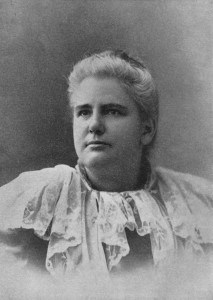 ministers in the Methodist Church. She also earned a medical degree though she never set-up a medical practice. While a speaker for the Women’s Christian Temperance Movement Susan B Anthony convinced her to join the National Women’s Suffrage Association (NWSA). Eventually Shaw would serve as the NWSA Vice-President from 1890 to 1904 and President from 1904 to 1915.
ministers in the Methodist Church. She also earned a medical degree though she never set-up a medical practice. While a speaker for the Women’s Christian Temperance Movement Susan B Anthony convinced her to join the National Women’s Suffrage Association (NWSA). Eventually Shaw would serve as the NWSA Vice-President from 1890 to 1904 and President from 1904 to 1915.
In 1907 Shaw was the featured speaker at the club’s annual Piazza Party at Lochland. Her subject was “Women and Peace.”
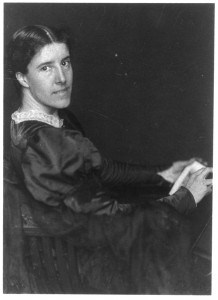 Charlotte Perkins Gilman (1860-1935) was an artist, feminist theorist, writer of fiction and non-fiction, and lecturer. Perhaps she is best known for the short story “The Yellow Wallpaper” (1892) and Women and Economics (1898). She believed that the problems facing women could be solved through financial independence, and she envisioned communal day cares and kitchens that would allow women to seek full-time employment. Her ideas influenced the development of care centers and take-out restaurants.
Charlotte Perkins Gilman (1860-1935) was an artist, feminist theorist, writer of fiction and non-fiction, and lecturer. Perhaps she is best known for the short story “The Yellow Wallpaper” (1892) and Women and Economics (1898). She believed that the problems facing women could be solved through financial independence, and she envisioned communal day cares and kitchens that would allow women to seek full-time employment. Her ideas influenced the development of care centers and take-out restaurants.
In 1903 Gilman was the featured speaker for Piazza Party at Lochland. Her subject was “Why Women Should Vote.”
Carrie Chapman Catt’s (1859-1947) participation in the Iowa Woman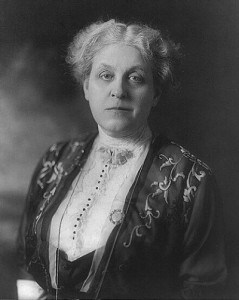 Suffrage Association led to her involvement with the National American Women’s Suffrage Association (NAWSA). From 1900 to 1904 and 1915 to 1920 she served as president of the NAWSA. Under Catt’s leadership, women’s suffrage gained the support of President Woodrow Wilson and both houses of Congress, which led to the passage of the 19th Amendment.
Suffrage Association led to her involvement with the National American Women’s Suffrage Association (NAWSA). From 1900 to 1904 and 1915 to 1920 she served as president of the NAWSA. Under Catt’s leadership, women’s suffrage gained the support of President Woodrow Wilson and both houses of Congress, which led to the passage of the 19th Amendment.
The Millers tried for several years to get Catt to speak in Geneva. Finally, in 1903 Catt spoke at the Smith Opera House. Her subject was “Woman and the State.”
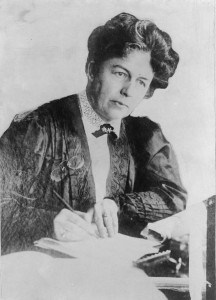 Like her mother Elizabeth Cady Stanton, Harriott Stanton Blatch (1856-1940) was active in the women’s rights movement. After spending twenty years in England raising a family, she returned to the United States in 1902 and formed the Women’s Political Union (WPU). Through the WPU, Blatch introduced British-style politics into the American suffrage movement. These methods included parades, outdoor rallies and poll watchers.
Like her mother Elizabeth Cady Stanton, Harriott Stanton Blatch (1856-1940) was active in the women’s rights movement. After spending twenty years in England raising a family, she returned to the United States in 1902 and formed the Women’s Political Union (WPU). Through the WPU, Blatch introduced British-style politics into the American suffrage movement. These methods included parades, outdoor rallies and poll watchers.
Blatch spoke several times in Geneva. In 1904 she was the featured speaker for Piazza Party at Lochland. Her subject was “Peace.”

Thanks for this Oct. 2 on “Suffrage Connection.” It reveals the interstices in the movement–valuable and inspiriting.